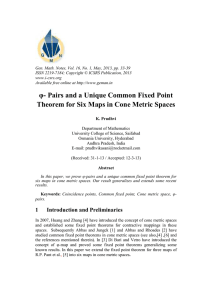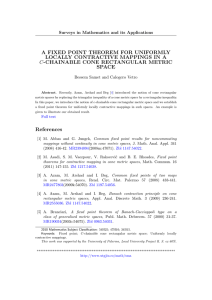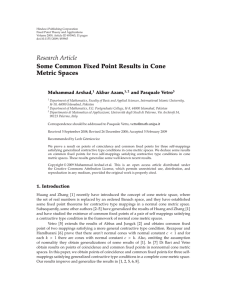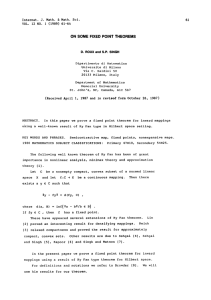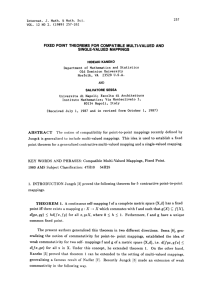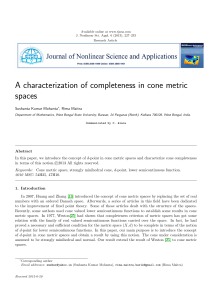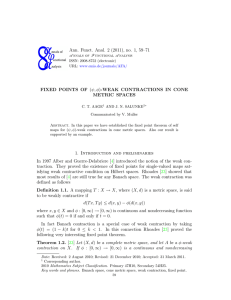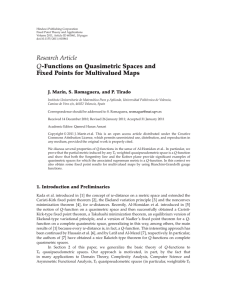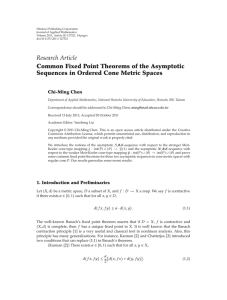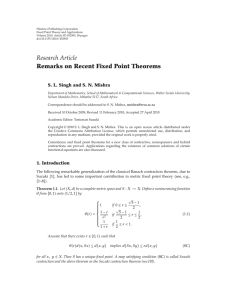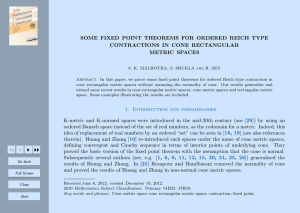Document 10858576
advertisement
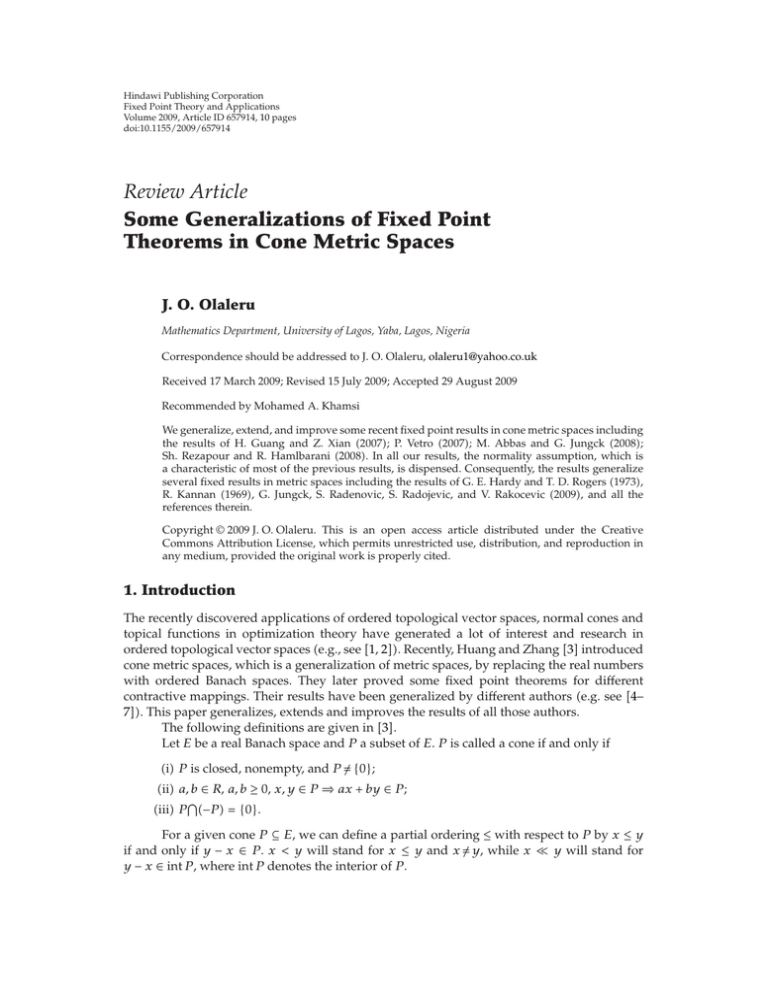
Hindawi Publishing Corporation
Fixed Point Theory and Applications
Volume 2009, Article ID 657914, 10 pages
doi:10.1155/2009/657914
Review Article
Some Generalizations of Fixed Point
Theorems in Cone Metric Spaces
J. O. Olaleru
Mathematics Department, University of Lagos, Yaba, Lagos, Nigeria
Correspondence should be addressed to J. O. Olaleru, olaleru1@yahoo.co.uk
Received 17 March 2009; Revised 15 July 2009; Accepted 29 August 2009
Recommended by Mohamed A. Khamsi
We generalize, extend, and improve some recent fixed point results in cone metric spaces including
the results of H. Guang and Z. Xian 2007; P. Vetro 2007; M. Abbas and G. Jungck 2008;
Sh. Rezapour and R. Hamlbarani 2008. In all our results, the normality assumption, which is
a characteristic of most of the previous results, is dispensed. Consequently, the results generalize
several fixed results in metric spaces including the results of G. E. Hardy and T. D. Rogers 1973,
R. Kannan 1969, G. Jungck, S. Radenovic, S. Radojevic, and V. Rakocevic 2009, and all the
references therein.
Copyright q 2009 J. O. Olaleru. This is an open access article distributed under the Creative
Commons Attribution License, which permits unrestricted use, distribution, and reproduction in
any medium, provided the original work is properly cited.
1. Introduction
The recently discovered applications of ordered topological vector spaces, normal cones and
topical functions in optimization theory have generated a lot of interest and research in
ordered topological vector spaces e.g., see 1, 2. Recently, Huang and Zhang 3 introduced
cone metric spaces, which is a generalization of metric spaces, by replacing the real numbers
with ordered Banach spaces. They later proved some fixed point theorems for different
contractive mappings. Their results have been generalized by different authors e.g. see 4–
7. This paper generalizes, extends and improves the results of all those authors.
The following definitions are given in 3.
Let E be a real Banach space and P a subset of E. P is called a cone if and only if
i P is closed, nonempty, and P / {0};
ii a, b ∈ R, a, b ≥ 0, x, y ∈ P ⇒ ax by ∈ P ;
iii P −P {0}.
For a given cone P ⊆ E, we can define a partial ordering ≤ with respect to P by x ≤ y
y, while x y will stand for
if and only if y − x ∈ P . x < y will stand for x ≤ y and x /
y − x ∈ int P , where int P denotes the interior of P .
2
Fixed Point Theory and Applications
The cone P is called normal if there is M > 0 such that for all x, y ∈ E, 0 ≤ x ≤ y
implies x ≤ My.
The least positive number M satisfying the above is called the normal constant of P .
The cone P is called regular if every increasing sequence which is bounded from
above is convergent. That is, if {xn }n≥1 is a sequence such that x1 ≤ x2 ≤ · · · ≤ y for some
y ∈ E, then there is x ∈ E such that limn → ∞ xn − x 0. Equivalently, the cone P is regular if
and only if every decreasing sequence which is bounded from below is convergent. In 5 it
was shown that every regular cone is normal.
In the sequel we will suppose that E is a metrizable linear topological space whose
topology is defined by a real-valued function F : X → R called F-norm see 8. We will
assume that P is a cone in E with int P /
0 and ≤ is partial ordering with respect to P .
Metrizable linear topological spaces contain metrizable locally convex spaces and
normed linear spaces 9. Therefore our E generalizes the E as a normed linear space used in
all the previous results on cone metric spaces.
A cone P ⊆ E is therefore called normal if there is M > 0 such that for all x, y ∈ E, 0 ≤
x ≤ y implies Fx ≤ MFy.
Definition 1.1. Let X be a nonempty set. Suppose that d : X × X → E satisfies
i 0 ≤ dx, y for all x, y ∈ X and dx, y 0 if and only if x y,
ii dx, y dy, x for all x, y ∈ X,
iii dx, y ≤ dx, z dz, y for all x, y, z ∈ X.
Then d is called a cone metric on X, and X, d is called a cone metric space.
Example 1.2 see 3. Let E R2 , P {x, y ∈ E : x, y ≥ 0}, X R, and d : X × X → E
defined by dx, y |x − y|, α|x − y|, where α ≥ 0 is a constant. Then X, d is a cone metric
space.
Clearly, this example shows that cone metric spaces generalize metric spaces.
We now give another example where E is a metrizable linear topological vector space
that is not a normed linear space.
Example 1.3. Let E p , 0 < p < 1, P {{xn }n≥1 ∈ E : xn ≥ 0, for all n}, X, ρ a metric space
and d : X × X → E defined by dx, y {ρx, y/2n }n≥1 . Then X, d is a cone metric space.
Definition 1.4. Let X, d be a cone metric space. Let {xn } be a sequence in X. If for every c ∈ E
with 0 c there is N such that for all n > N, dxn , x c, then {xn } is said to be convergent
to x ∈ X, that is, limn → ∞ xn x.
Definition 1.5. Let X, d be a cone metric space. Let {xn } be a sequence in X. If for every c ∈ E
with 0 c there is N such that for all n, m > N, dxn , xm c, then {xn } is called a Cauchy
sequence in X.
It is shown in 3 that a convergent sequence in a cone metric space X, d is a Cauchy
sequence.
Definition 1.6. Let X, d be a cone metric space. If for any sequence {xn } in X, there is a
subsequence {xni } of {xn } such that {xni } is convergent in X, then X is called a sequentially
Fixed Point Theory and Applications
3
compact metric space. Furthermore, X is compact if and only if X is sequentially compact.
see also 10.
Proposition 1.7 see 3. Let X, d be a cone metric space, P a normal cone. Let {xn } and {yn } be
two sequences in X and xn → x, yn → y as n → ∞. Then
i {xn } converges to x if and only if dxn , x → 0 as n → ∞
ii The limit of {xn } is unique
iii {xn } is a Cauchy sequence if and only if dxn , xm → 0 as n, m → ∞
iv dxn , yn → dx, y as n → ∞
Huang and Zhang 3 proved the following theorems for E a Banach space.
Theorem 1.8. Let X, d be a complete metric space, P a normal cone with normal constant M.
Suppose that the mapping T : X → X satisfies the contractive condition
d T x, T y ≤ kd x, y ,
∀x, y ∈ X,
1.1
where k ∈ 0, 1 is a constant. Then T has a unique fixed point in X. And for any x ∈ X, iterative
sequence {T n x} converges to the fixed point.
Theorem 1.9. Let X, d be a complete metric space, P a normal cone with normal constant M.
Suppose that the mapping T : X → X satisfies the contractive condition
d T x, T y ≤ k dT x, x d T y, y ,
∀x, y ∈ X,
1.2
where k ∈ 0, 1/2 is a constant. Then T has a unique fixed point in X. And for any x ∈ X, iterative
sequence {T n x} converges to the fixed point.
Theorem 1.10. Let X, d be a complete metric space, P a normal cone with normal constant M.
Suppose that the mapping T : X → X satisfies the contractive condition
d T x, T y ≤ k d T x, y d T y, x ,
∀x, y ∈ X,
1.3
where k ∈ 0, 1/2 is a constant. Then T has a unique fixed point in X. And for any x ∈ X, iterative
sequence {T n x} converges to the fixed point.
Rezapour and Hamlbarani 5 improved on Theorems 1.8–1.10 by proving the same
results without the assumption that P is a normal cone. They gave examples of non-normal
cones and showed that there are no normal cones with normal constant M < 1. Observe that
the normal constant M for Example 1.3 is 1.
Vetro 7 recently combined the results of Theorems 1.8 and 1.9 and generalized them
to two maps satisfying certain conditions, to obtain the following theorem.
Theorem 1.11. Let X, d be a cone metric space, P a normal cone with normal constant M. Let
f, g : X → X be mappings such that
d fx, f y ≤ ad fx, gx bd f y , y cd gx, y
1.4
4
Fixed Point Theory and Applications
for all x, y ∈ X where a, b, c ∈ 0, 1 and a b c < 1. Suppose
f gx g gx
if fx gx
1.5
and fX ⊂ gX and fX or gX is a complete subspace of X, then the mappings f and g have a
unique common fixed point. Moreover, for any xo ∈ X, the sequence {fxn } of the initial point xo ,
where {xn } ∈ X is defined by gxn fxn−1 for all n, converges to the fixed point.
Remark 1.12. The two maps f and g are said to be weaklycompatible if they satisfy condition
1.5. This concept was introduced by Huang and Zhang 3 and it is known to be the most
general among all commutativity concepts in fixed point theory. For example every pair of
weakly commuting self-maps and each pair of compatible self-maps are weakly compatible,
but the converse is not always true. In fact, the notion of weakly compatible maps is more
general than compatibility of type A, compatibility of type B, compatibility of type C,
and compatibility of type P. For a review of those notions of commutativity, see 11, 12.
In Theorem 2.1, we unify Theorems 1.8–1.10 into a single theorem and generalize. In
Theorem 2.3, we examine the situation where the sum of the coefficients, rather than less than
1, is actually 1. Theorem 3.1 generalizes Theorem 2.1 to two weakly compatible maps thus
extending Theorem 1.11. Furthermore, we remove the assumption of normality of cone P in
all our results and extend E to a metrizable linear topological space. Some other consequences
follow.
2. Theorems on Single Maps
Theorem 2.1. Let X, d be a complete cone metric space and f : X → X be mappings such that
d fx, f y ≤ a1 d fx, x a2 d f y , y a3 d f y , x a4 d fx, y a5 d y, x
2.1
for all x, y ∈ X where a1 , a2 , a3 , a4 , a5 ∈ 0, 1 and a1 a2 a3 a4 a5 < 1. Then the mappings f
have a unique fixed point. Moreover, for any x ∈ X, the sequence {f n x} converges to the fixed point.
Proof. We adapt the technique in 13. Without loss of generality we may assume that a1 a2
and a3 a4 so that from 2.1, we have
a1 a2 a3 a4 d fx, f y ≤
d fx, x d f y , y d f y ,x
2
2
d fx, y a5 d y, x .
2.2
Set y fx in 2.1 and simplify to obtain
a a a3
1
5
d x, fx d x, f 2 x .
d fx, f 2 x ≤
1 − a2
1 − a2
2.3
Fixed Point Theory and Applications
5
By the triangle inequality, dfx, f 2 x ≥ df 2 x, x − dfx, x and so from 2.3 we get
a1 a5 a3
d f 2 x, x − d fx, x ≤
d x, fx d x, f 2 x ,
1 − a2
1 − a2
2.4
which on simplifying gives
1a a −a 1
5
2
d f 2 x, x ≤
d x, fx .
1 − a2 − a3
2.5
Substituting 2.5 into 2.3 we obtain
a a a 1
3
5
d fx, f 2 x ≤
d x, fx ,
1 − a2 − a3
2.6
and by symmetry, we may exchange a1 with a2 and a3 with a4 in 2.6 to obtain
a a a 2
4
5
d fx, f 2 x ≤
d x, fx .
1 − a1 − a4
2.7
If α min{a1 a3 a5 /1 − a2 − a3 , a2 a4 a5 /1 − a1 − a4 }, then
d fx, f 2 x ≤ αd x, fx ,
2.8
where α ∈ 0, 1. Let m > n, then in view of 2.8, we obtain
d f m x, f n x ≤ d f m x, f m−1 x · · · d f n1 x, f n x
≤ αn 1 α · · · αm−n d x, fx
≤
2.9
α
d x, fx .
1−α
n
Let 0 c be given and choose a natural number N1 such that αn /1 − αdx, fx c for
all n ≥ N1 . Thus,
d f m x, f n x c
2.10
for n > m. Therefore, {f n x}n≥1 is a Cauchy sequence in X, d. Since X, d is complete, there
exists x∗ ∈ X such that f n x → x∗ . Choose a natural number N2 such that for all n ≥ N2 ,
c1 − a2 a3 d f n x, x∗ ,
2a1 a4 1
c1 − a2 a3 d f n−1 x, x∗ .
2a1 a3 a5 2.11
6
Then
Fixed Point Theory and Applications
d fx∗ , x∗ ≤ d f n x, fx∗ d f n x, x∗
≤ a1 d f n x, f n−1 x a2 d fx∗ , x∗ a3 d fx∗ , f n−1 x
a4 d f n x, x∗ a5 d f n−1 x, x∗ d f n x, x∗
≤ a1 d f n x, x∗ a1 d f n−1 x, x∗ a2 d fx∗ , x∗
a3 d fx∗ , x∗ a3 d f n−1 x, x∗ a4 d f n x, x∗
2.12
a5 d f n−1 x, x∗ d f n x, x∗
≤
a1 a3 a5 n−1
a1 a4 1 n
d f x, x∗ d f x, x∗
1 − a2 a3 1 − a2 a3 c c
c.
2 2
Thus, dfx∗ , x∗ c/m, for all m ≥ 1. So c/m − dfx∗ , x∗ ∈ P , for all m ≥ 1. Since
c/m → 0 as m → ∞, and P is closed, −dfx∗ , x∗ ∈ P . But dfx∗ , x∗ ∈ P and so
dfx∗ , x∗ 0. Hence fx∗ x∗ . The uniqueness follows from the contractive definition of
f in 2.1.
Remark 2.2. The theorem is valid if we replace the completeness of X with the condition that
fX is complete. If E is restricted to a normed linear space and a1 a2 a3 a4 0 in
Theorem 2.1 we have 5, Theorem 2.3; if a3 a4 a5 0 in Theorem 2.1, we obtain 5,
Theorem 2.6; if a1 a2 a5 0, we obtain 5, Theorem 2.7 and if a1 a2 a3 0, we
obtain 5, Theorem 2.8. Furthermore, if we add the normality assumption to Theorem 2.1,
then 3, Theorems 1, 2, and 4 there are special cases of Theorem 2.1.
Thus Theorem 2.1 is both an extension generalization and an improvement of the
results of 3, 5.
We now consider the situation where a1 a2 a3 a4 a5 1 in Theorem 2.1.
Theorem 2.3. Let X, d be a sequentially compact cone metric space and f : X → X be a continuous
mapping such that
d fx, f y < a1 d fx, x a2 d f y , y a3 d f y , x a4 d fx, y
a5 d y, x ,
2.13
for all x, y ∈ X, x / y where a1 , a2 , a3 , a4 , a5 ∈ 0, 1 and a1 a2 a3 a4 a5 1. Then the
mappings f have a unique fixed point.
Proof. We follow the same argument as Theorem 2.1. Without loss of generality, we may
assume that a1 a4 and a2 a3 are less than 1. Hence 2.8 becomes
d fx, f 2 x < d x, fx .
2.14
Fixed Point Theory and Applications
7
Since X is sequentially compact, then it is compact 10. The fact that f is continuous and
X is compact implies that fX is compact and hence inf{dx, fx : x ∈ X} exists and
inf{dx, fx : x ∈ X} dy, fy for some y ∈ X. From 2.14, it can be infered that y is
fixed under f and uniqueness follows from 2.13.
Remark 2.4. If a1 a2 a3 a4 0, with the additional assumption that P is a regular
cone in Theorem 2.3, we obtain 3, Theorem 2. Thus Theorem 2.3 is both an extension and
improvement of 3, Theorem 2.
3. Common Fixed Points
Theorem 3.1. Let X, d be a cone metric space and let f, g : X → X be mappings such that
d fx, f y ≤ a1 d fx, gx a2 d f y , g y a3 d f y , gx
a4 d fx, g y a5 d g y , gx
3.1
for all x, y ∈ X where a1 , a2 , a3 , a4 , a5 ∈ 0, 1 and a1 a2 a3 a4 a5 < 1. Suppose f and g
are weakly compatible and fX ⊂ gX such that fX or gX is a complete subspace of X, then
the mappings f and g have a unique common fixed point. Moreover, for any xo ∈ X, the sequence
{xn } ⊂ X defined by gxn fxn−1 for all n, converges to the fixed point.
Proof. Observe that if f satisfies 3.1, it also satisfies
d fx, f y ≤ kd fx, gx kd f y , g y ld f y , gx
ld fx, g y md g y , gx
3.2
for all x, y ∈ X where k, l, m ∈ 0, 1 and 2k 2l m < 1, 2k a1 a2 , 2l a3 a4 , a5 m.
If fxn fxn−1 for all n ∈ N, then {fxn } is a Cauchy sequence. Suppose
fxn−1 for all n ∈ N. Using 3.2 and the fact that gxn fxn−1 for all n, we
fxn /
have
d fxn1 , fxn ≤ kd fxn1 , fxn kd fxn , fxn−1 ld fxn , fxn ld fxn1 , fxn ld fxn , fxn−1 md fxn−1 , fxn ≤
3.3
klm d fxn−1 , fxn .
1 − k l
Consequently
d fxn1 , fxn ≤
klm
1 − k l
n
d fxo , fx1 .
3.4
8
Fixed Point Theory and Applications
Now, for all m, n ∈ N, with n > m, we have
d fxn , fxm ≤ kd fxn , fxn−1 kd fxn−1 , fxn−2 · · · d fxm1 , fxm kn−1 kn−2 · · · km d fxo , fx1 ≤
km
dfxo , fx1 ,
1−k
3.5
where k k l m/1 − k l ∈ 0, 1.
Let 0 c be given and choose a natural number N1 such that km /1−kdx, fx c for all m ≥ N1 . Thus,
d fxm , fxn c
3.6
for n > m. Therefore, {fxn }n≥1 is a Cauchy sequence. Since fX or gX is complete, then
there exists x∗ ∈ gX such that fxn → x∗ and gxn → x∗ . Let y ∈ X such that gy x∗ .
We claim that fy gy. From 3.2, we have
d fxn , f y ≤ kd fxn , gxn kd f y , g y ld f y , gxn ld fxn , g y md g y , gxn .
3.7
As n → ∞ we obtain
d x∗ , f y ≤ kd f y , g y ld f y , x∗ ld x∗ , g y md g y , x∗
k ld x∗ , f y , and hence x∗ f y g y .
3.8
Since fy gy and f and g are weakly compatible, then
fx∗ f g y g g y gx∗ .
3.9
Next we show that x∗ fx∗ gx∗ . Suppose fx∗ /
x∗ , from 3.2, we have
d fx∗ , f y ≤ kd fx∗ , gx∗ kd f y , g y ld f y , gx∗ ld fx∗ , g y md g y , gx∗ 2ld f y , gx∗ 2ld f y , fx∗ .
3.10
This is a contradiction and hence fx∗ x∗ gx∗ . Thus x∗ is a common fixed point of f
and g. The uniqueness follows from 3.1.
Remark 3.2. i If a3 a4 0 and E is restricted to normed linear spaces in Theorem 3.1, with
the additional normality assumption, we obtain the common fixed point Theorem of Vetro
7.
Fixed Point Theory and Applications
9
ii Suppose E is restricted to normed linear spaces, with the additional normality
assumption, if a1 a2 a3 a4 0, then Theorem 3.1 gives 4, Theorem 2.1; if a3 a4 a5 0, we obtain 4, Theorem 2.3, and if a1 a2 a5 0, we obtain 4, Theorem 2.4. Thus
our theorem is both an extension, generalization and an improvement of the results of 4, 7.
iii If E is restricted to normed linear spaces, Theorem 3.1 reduces to 14, Theorem
2.8.
iv If in Theorem 3.1 we choose choose g IX the identity mapping on X, we have
Theorem 2.1.
Open Question
Theorem 2.3 was proved for the usual metric space by the author in 15 without the
assumptions that f is continuous and X is compact. Is the above Theorem 2.3 still valid if
we remove the assumption that f is continuous and X is compact?.
Acknowledgments
The author is grateful to the referees for careful readings and corrections. He is also grateful
to Professor Stojan Radenvonic for giving him all the papers on cone metric spaces used in
this paper and the African Mathematics Millennium Science Initiative AMMSI for financial
support.
References
1 H. Mohebi, “Topical functions and their properties in a class of ordered Banach spaces,” in Continuous
Optimization, Current Trends and Modern Applications, vol. 99, pp. 343–361, Springer, New York, NY,
USA, 2005.
2 H. Mohebi, H. Sadeghi, and A. M. Rubinov, “Best approximation in a class of normed spaces with
star-shaped cone,” Numerical Functional Analysis and Optimization, vol. 27, no. 3-4, pp. 411–436, 2006.
3 L.-G. Huang and X. Zhang, “Cone metric spaces and fixed point theorems of contractive mappings,”
Journal of Mathematical Analysis and Applications, vol. 332, no. 2, pp. 1468–1476, 2007.
4 M. Abbas and G. Jungck, “Common fixed point results for noncommuting mappings without
continuity in cone metric spaces,” Journal of Mathematical Analysis and Applications, vol. 341, no. 1,
pp. 416–420, 2008.
5 Sh. Rezapour and R. Hamlbarani, “Some notes on the paper “Cone metric spaces and fixed point
theorems of contractive mappings”,” Journal of Mathematical Analysis and Applications, vol. 345, no. 2,
pp. 719–724, 2008.
6 S. M. Veaspour and P. Raja, “Some extensions of Banach contraction principle in complete cone metric
spaces,” Fixed Point Theory and Applications, vol. 2008, Article ID 768294, 11 pages, 2008.
7 P. Vetro, “Common fixed points in cone metric spaces,” Rendiconti del Circolo Matematico di Palermo,
vol. 56, no. 3, pp. 464–468, 2007.
8 N. Adasch, B. Ernst, and D. Keim, Topological Vector Spaces, vol. 639 of Lecture Notes in Mathematics,
Springer, Berlin, Germany, 1978.
9 A. P. Robertson and W. Robertson, Topological Vector Spaces, vol. 53 of Cambridge Tracts in Mathematics,
Cambridge University Press, Cambridge, UK, 2nd edition, 1980.
10 Sh. Rezapour, “A review of topological properties of cone metric spaces,” in Proceedings of the
Conference on Analysis, Topology and Applications (ATA ’08), Vrnjačka Banja, Serbia, May-June 2008.
11 A. Djoudi and A. Aliouche, “Common fixed point theorems of Gregus type for weakly compatible
mappings satisfying contractive conditions of integral type,” Journal of Mathematical Analysis and
Applications, vol. 329, no. 1, pp. 31–45, 2007.
12 G. Jungck and B. E. Rhoades, “Fixed points for set valued functions without continuity,” Indian Journal
of Pure and Applied Mathematics, vol. 29, no. 3, pp. 227–238, 1998.
10
Fixed Point Theory and Applications
13 G. E. Hardy and T. D. Rogers, “A generalization of a fixed point theorem of Reich,” Canadian
Mathematical Bulletin, vol. 16, pp. 201–206, 1973.
14 G. Jungck, S. Radenovic, S. Radojevic, and V. Rakocevic, “Common fixed theorems of weakly
compatile pairs on cone metric spaces,” Fixed Point Theory and Applications, vol. 59, Article ID 643840,
13 pages, 2009.
15 J. O. Olaleru and H. Akewe, “An extension of Gregus fixed point theorem,” Fixed Point Theory and
Applications, vol. 2007, Article ID 78628, 8 pages, 2007.
